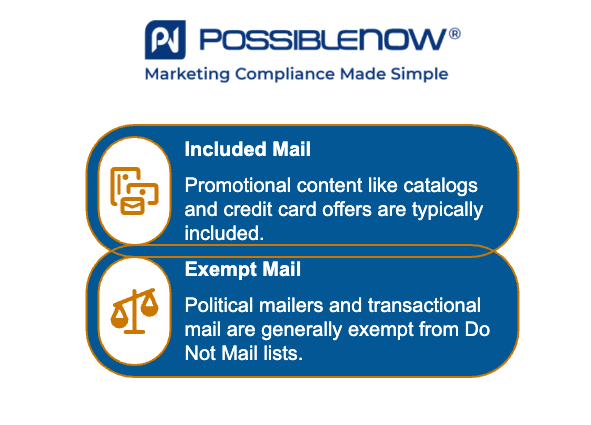Resource Center
What Is a ‘Do Not Mail’ List and How Does It Work?
Type: Blog
Topic: Do Not Call Solution

A Do Not Mail list is a registry of consumers who have opted out of receiving unsolicited marketing mail. Unlike government-run Do Not Call registries, these lists are typically managed by industry groups like the Direct Marketing Association (DMA), and participation is voluntary for marketers. The primary goal is to reduce unwanted print communications, cut waste, and build trust with consumers by honoring their privacy preferences.
For marketers, here’s what you need to know:
- Do Not Mail lists are not legally mandated, but ignoring them can damage your brand.
- Consumers register via platforms like DMAchoice to stop mail from participating brands.
- Certain categories of mail are exempt, including political ads and local business mail.
- Marketers who choose to participate in these programs should actively scrub their mailing lists to honor consumer opt-out requests.
In the following sections, you’ll find information on:
Speak With an Expert Today
Types of Mail Included (and What’s Exempt)

Do Not Mail lists typically apply to promotional content such as:
- Catalogs
- Credit card or insurance offers
- Magazine subscriptions
- Fundraising solicitations
- General advertising
However, the following are generally not covered:
- Political mailers
- Nonprofits (unless opted out separately)
- Local business flyers
- Transactional mail (e.g., bills or account updates)
- Mail from companies the consumer recently interacted with
How Consumers Opt Out of Mail
Consumers opt out by registering with organizations like the DMAchoice Mail Preference Service, often for a nominal fee. Registration is valid for a set number of years (typically 10). Consumers can:
- Submit an online request through DMAchoice.org
- Use third-party tools like CatalogChoice or PaperKarma for specific brands
- Combine efforts with credit bureau opt-outs via OptOutPrescreen.com
The effectiveness depends on marketer participation. Brands that subscribe to these services can match their mailing lists against suppression files to avoid sending materials to consumers who have opted out.
Why Marketers Comply Without a Legal Mandate
Unlike the Do Not Call Registry governed by the FTC and enforced under the Telemarketing Sales Rule (TSR), Do Not Mail lists operate under industry self-regulation. That means there are:
- No federal laws requiring marketers to comply
- No fines from regulators for sending mail to listed consumers
Many brands choose to participate regardless of the lack of legal requirement. The motivation is reputational rather than regulatory. Consumers increasingly expect companies to respect their privacy preferences across all communication channels, not only where compliance is mandatory.
Sending mail to someone who has opted out, whether or not it is legally required, signals a lack of respect for customer boundaries. Participating in these lists is a proactive way to demonstrate responsibility and reinforce consumer trust.
Suppression Flow for Marketers
Participating marketers receive access to suppression files that list opted-out individuals. Here’s what that process typically involves:
- Subscribing to the list through the DMA or similar provider
- Matching the suppression file against your internal mailing lists
- Removing or flagging contacts who’ve opted out
- Documenting and periodically repeating the process to stay up to date
This process is especially valuable for enterprises running high-volume direct mail operations, allowing them to streamline targeting while showing respect for consumer choices.
Risks of Non-Compliance
While there’s no legal penalty for ignoring a Do Not Mail list, the potential consequences are meaningful:
- Higher rates of opt-outs and customer dissatisfaction
- Greater likelihood of negative feedback on social platforms or review sites
- Erosion of brand trust, particularly in industries where credibility is essential
- Missed opportunities to show leadership on privacy and customer respect
In a market increasingly shaped by consumer control and expectations, marketers who disregard voluntary preferences risk falling out of step with their audience—even when the law does not require action.
Combining Mail Suppression With Other Compliance Strategies
Mail preferences are one piece of a larger compliance and customer experience framework. Without coordination across channels, brands risk inconsistency in how they apply consumer choices, especially when the same individual receives messages by phone, email, text, and mail.
To maintain consistency, marketers can coordinate physical mail opt-outs with other suppression and consent systems, including:
- Do Not Call lists, to stay aligned with the Telemarketing Sales Rule (TSR)
- Email unsubscribe management, to comply with CAN-SPAM and CASL requirements
- Text message opt-outs, to meet TCPA and mobile marketing standards
- Enterprise-wide consent tools, such as MyPreferences, to centralize customer permissions across all channels
Integrating these systems helps maintain a single, accurate view of each customer’s preferences. This approach supports compliance, avoids redundant outreach, and demonstrates a unified commitment to respecting privacy across the entire organization.
PossibleNOW Unifies Consent Management
With PossibleNOW’s DNCSolution, organizations can scrub contacts across channels, including print, while reducing legal exposure through real-time compliance tools and a full historical audit trail. When integrated with MyPreferences, marketers can centralize consent across direct mail, email, SMS, and more, maintaining a unified view of each customer’s communication wishes.
To help protect your brand and simplify compliance across channels, talk to PossibleNOW today about building a smarter, more unified consent strategy.
Request a Demo Today
About PossibleNOW
PossibleNOW is the pioneer and leader in customer consent, preference, and regulatory compliance solutions. We leverage our MyPreferences technology, processes, and services to enable relevant, trusted, and compliant customer interactions. Our platform empowers the collection, centralization, and distribution of customer communication consent and preferences across the
enterprise. DNCSolution addresses Do Not Contact regulations such as TCPA, CAN-SPAM and CASL, allowing companies to adhere to DNC requirements, backed by our 100% compliance guarantee.
PossibleNOW’s strategic consultants take a holistic approach, leveraging years of experience when creating strategic roadmaps, planning technology deployments, and designing customer interfaces. PossibleNOW is purpose-built to help large, complex organizations improve customer experiences and loyalty while mitigating compliance risk.
-
TCPA Regulations and Compliance: Complete Guide
Type: Blog
Topic: Do Not Call Solution
-
Defining Meaningful Metrics: 6 Soft KPIs to Measure Customer Preference Collection
Type: Blog
Topic: Preference Mgmt
-
Email Preference Center Best Practices
Type: Blog
Topic: Preference Mgmt
-
The Basics of DNC Scrubbing: What Is a Do Not Call (DNC) Scrubber and Why Do You Need It?
Type: Blog
Topic: Do Not Call Solution
-
What is Consent Management, How it Works, & Why it’s Important for Data Compliance
Type: Blog
Topic: Consent Mgmt
-
Do Insurance Companies Cover TCPA Damages?
Type: Blog
Topic: Do Not Call Solution
-
8 Best Practices for Capturing GDPR Consent
Type: Webinars
-
Data Silos Cause Communication Gaps
Type: Videos
Topic: Preference Mgmt
-
Difference Between Preferences & Consent
Type: Videos
Topic: Preference Mgmt
-
Integrate Do Not Call Compliance with Preferences
Type: Videos
Topic: Preference Mgmt
-
Customer Preferences Require More Than One Flavor
Type: Videos
Topic: Preference Mgmt
-
Give Customers Opt-Down Options
Type: Videos
Topic: Preference Mgmt
-
Preference Center Organization
Type: Videos
Topic: Preference Mgmt
-
Strategic Consultants Benefited Scotiabank
Type: Videos
Topic: Industry Testimonials
-
Best Practices for Managing Do Not Email Lists
Type: Blog
Topic: Do Not Call Solution
-
How Do Not Call Rules Apply to Nonprofit Organizations
Type: Blog
Topic: Do Not Call Solution
-
How to Train Your Call Center on DNC Rules
Type: Blog
Topic: Do Not Call Solution
